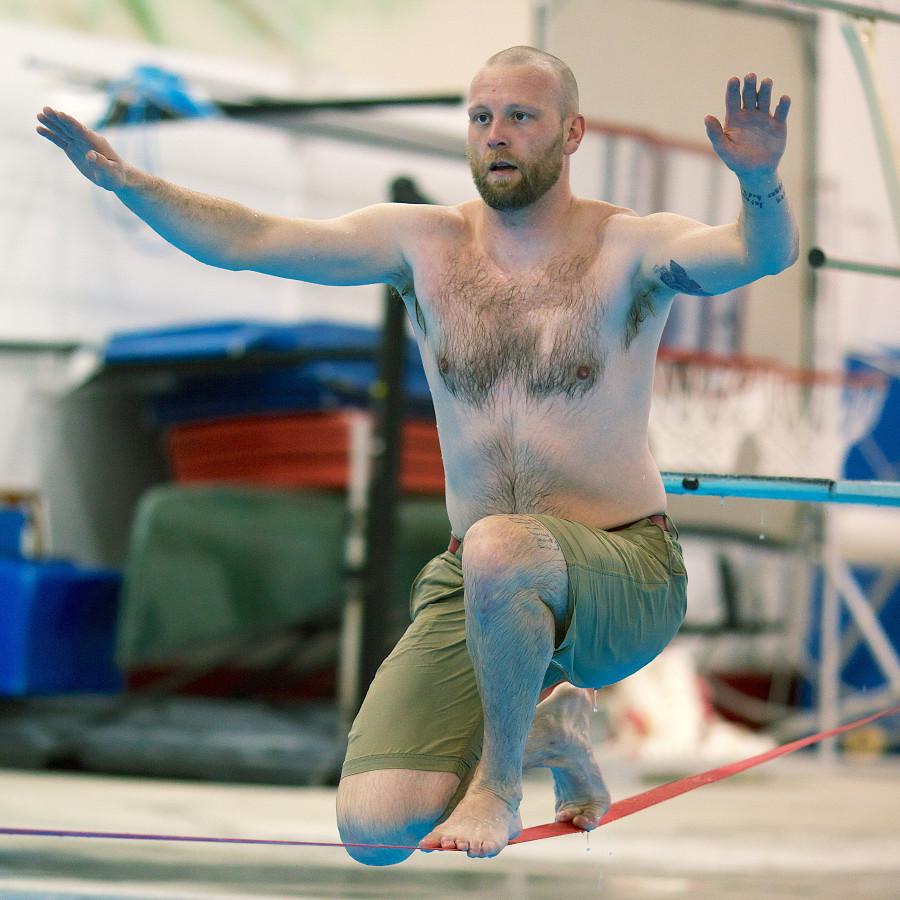Slackliners balance a thin, wavering line
February 5, 2014
Balanced over a pool, EWU students practice their slacklining, a current trend becoming more prominent on campus.
Slacklining originated in Yosemite Valley, Calif., it soon became prominent in the mid to late 1970s.
There is one main skill that one must have in order to successfully take part in this sport. “Slacklining’s main purpose is to help your balance, and it’s just a fun activity you can do in your leisurely time,” EPIC adventures climbing wall instructor and supervisor James Mower said. “A lot of climbers slackline mostly to improve [their] balance and [to] improve their core strength.”
Mower has been slacklining for three years; when he came to Eastern the climbing club had set up a line outside of the PUB. “I went there, thoroughly enjoyed it and by that spring I actually bought my own slackline,” Mower said.
The activity is easy to set up, it is cheap and a lot of the equipment comes from climbing. According to http://www.slackline.com, there are a lot more people taking part in this sport in city parks and campgrounds. There has even been a push to make slacklining a club sport as well, but so far, efforts have been unsuccessful.
Eastern students on campus can be found participating in this activity outside on campus during spring when the weather is better. “We have gone through the process of adding slacklining to one of our list of activities,” Mower said.
“Last year, the climbing club was the sponsor of the slackline over the pool. But we have found that having it as a club sport would be a difficult process to go through because slacklining’s such a social sport, it’s not as much of a competition.”
Slacklining over pool areas is an alternate option when participating in this activity. “Going over water is exciting because if you fall there’s less chance of getting hurt, and you can do more risky things. A lot of people I’ve seen will actually back flip into the water,” Mower said.
Setting up the slacklining equipment over pool areas is usually done the same way as the original sport. “It’s just a different way of doing it over water, it doesn’t change much except for the landing really,” EPIC adventures assistant manager Benjamin Ward said.
At Eastern’s pool, students use the facility to their advantage in order to perform moves while slacklining. “There’s a really deep section that they use the diving boards for. There’s a high board and a normal low board that they use for tricks and learning,” Ward said.
Besides swimming pools, there are other ways to participate in this sport. Highlining is another way to slackline, the slackline rope is usually tied to high mountain ranges or other high places of elevation. This is done at higher altitudes with a much greater risk because of higher elevation starting at heights of 25 feet.
The low element version of slacklining is what is done on Eastern’s campus during warm weather. Yoga can be done on this version for relaxation as well. The low element slackline is typically used between two trees when it is taking place outside.
Ward has been participating in slacklining for two to three years. “I don’t know if I could equate myself to any sort of skill level,” Ward said. “That’s not even the reason why I do it.” Ward does slacklining for fun, and is just another hobby for him.
As far as introducing slacklining to more people, Ward has some advice. “You can give them a hand, something to hold on to, to make it easier to start with,” Ward said. “Get them enthusiastic about it. Tell them why it’s cool, [and] show them why it’s cool; explain how the system works.”









